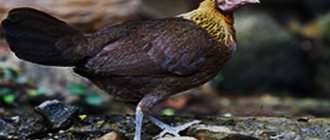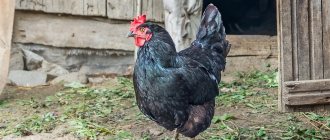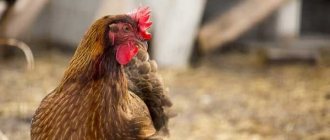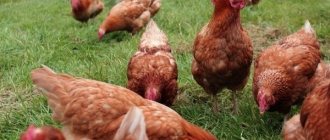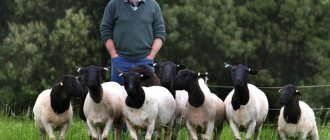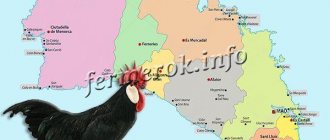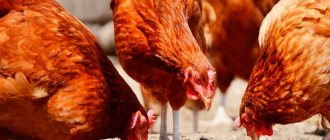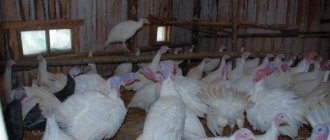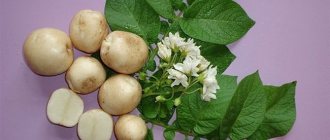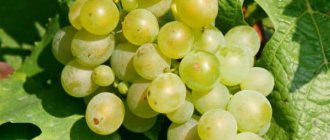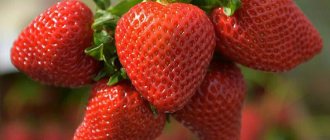Poultry farming » Chickens
0
1753
Article rating
Kira Stoletova
Xin-Xin Dian chickens come from China and belong to the egg breeding category. Every year they are gaining popularity due to their unpretentiousness, high productivity and attractive appearance. It is interesting that the original idea was to breed a fighting breed, but the result was a peaceful, egg-laying chicken, small in size, capable of laying up to 200 eggs per year.
Chicken breed Xin Xin Dian
Historical information about the breed
The Xin Xin Dian breed owes its appearance to Chinese breeders from the Shanghai Poultry Institute. Working to improve the Wuheiliu breed, the Chinese bred new chickens.
Breeders wanted, by reducing the weight of the bird, to increase its egg production and maturation rate. As a result, new meat-and-egg chickens were created - gentle in character, productive and attractive blacklings. Khabarovsk poultry farmer N. Roshchin was the first to bring them from China to Russia.
The long name of the breed is Xin Xin Dian, translated as “hen that lays green eggs.”
Exterior of a bird
The breed is most often represented by black plumage. But among the blacklings there are also chickens of red and brick-red shades. In appearance, these small birds correspond to the exterior of egg breeds.
External features of the breed:
- The body is trapezoidal, with light bones.
- The back is straight, the chest is rounded.
- The head is neat, the small, non-feathered part is red.
- Lobes with scarlet earrings.
- The ridge is well developed, leaf-shaped.
- The neck is wide, of medium length.
- The legs are yellow-gray, short, straight, without feathers.
- The thighs and shins are small.
- The wings are medium-sized, tightly pressed to the body.
- The tail is set high and bushy.
Individuals of red and brick-red color are difficult to distinguish from laying hens of other breeds.
Characteristics
Compared to many other Chinese breeds, these chickens do not have any special external characteristics that make them stand out from the “crowd”. These are just good-quality black hens with good productivity indicators. Let's learn more about the character and economic potential of this breed.
Character of Xin Xin Dian
What is known about the character and abilities of Xin Xin Dian:
- They are active, mobile, and fly well - they can rise to a height of up to 2 m.
- Neat and disciplined - ideal laying hens and poultry house residents. At night they sleep on perches, laying eggs only in nests, and not scattering them anywhere.
- Not aggressive, they easily get along in the same territory with other bird species. Even roosters are not particularly pugnacious, only sometimes they can compete for primacy.
Puberty and egg production
As Chinese breeders wanted, the Xin Xin Dian breed is characterized by very early maturation. Laying begins at 4-4.5 months. But the bird has not yet matured by this time; the peak of its egg production is ahead.
In the second year, hens reach maximum egg production and lay larger eggs. In the third year, the number of eggs laid begins to decline. It is profitable to slaughter three-year-old chickens for meat, completely renewing the flock.
For an overview of the Xin Xin Dian chicken breed + characteristics of their egg production, see the following video:
Productivity
Xin Xin Dian chickens not only lay eggs well, but also produce meat with excellent taste characteristics. That is why our poultry farmers consider this breed as a universal one - egg and meat.
Productivity indicators:
- The weight of eggs in the first year is 55 g, in the second year – 60 g.
- The number of eggs laid per year is 250.
- The weight of a laying hen is up to 1.5 kg, a rooster is up to 2 kg.
- Chick survival rate is up to 98%.
The breed is productive, but this is not the main thing for which Chinese nigellas are valued. Their main feature is the unique composition of eggs. They are rich in vitamins, minerals and fatty acids. The shells of eggs are of an unusual color - from turquoise to blue. Older hens lay darker eggs. The color of the chickens does not depend on the shade of the shell.
Regular consumption of eggs from Xin Xin Dian chickens normalizes hormonal levels, strengthens the immune system and restores the nervous system.
Poultry farmers often argue whether Xin-Xin-Dian is a breed or a cross. The question should be addressed to Chinese breeders. The Chinese themselves are no longer concerned about the issue of breed, but about productivity. Therefore, hybrids may also come across under the above name.
Crosses lay blue and marsh colored eggs. If there are such in the clutch, it means that the breed is unclean - it is not Xin Xin Dian, but its cross with other Chinese chickens.
Hatching instinct
In industrial poultry farming, they do not pay much attention to the brooding instinct - today there are large incubators for hatching eggs. Many modern incubators are even better at handling the hatching mission than chickens. But for small private farms, laying hens capable of breeding offspring are very convenient.
Xin Xin Dian chickens, unlike most Chinese breeds of this type, are excellent brood hens. In any case, 60-70% of all laying hens are able to hatch chicks.
The larger the number of chickens on a farm, the more often farmers use incubators. Artificial incubation has its advantages - it is more reliable and more productive.
We recommend reading the article about the features of incubating chicken eggs at home.
Description of the breed
Farmers' hesitation between egg and meat breeds often leads to a compromise when choosing the meat and egg direction.
An interesting option was the Xin-Xin Dian breed, which appeared more than 20 years ago in Shanghai. The rather ordinary appearance of chickens is compensated by the unusual coloring of the eggs and their properties, which began to be used to treat diseases of the digestive, immune, endocrine and cardiovascular systems.
The cost of eggs for incubation is 70 rubles per 1 piece, young eggs - 180, adults - 1200. Depending on the region, prices may vary significantly.
Appearance
At first glance, they have all the signs of an egg breed. But the weight of the adult bird and the well-developed sternum indicate mixed characteristics.
Nevertheless, this breed also has its own standards, which appeared as a result of a set of measures to improve the already existing Ukheyilyu species. The result was chickens that looked similar to their ancestors, but with a more peaceful attitude, obedient, and possessing a brooding instinct.
The color of the feathers is predominantly black; there are specimens with reddish or red plumage; these are considered an exception.
Scarlet earrings and a comb look impressive against a black background. The weight of an adult bird ranges from 1.2 to 2 kg. Roosters are traditionally larger than hens. A powerful belly, medium-sized wings tightly pressed to the sides and relatively small shins give a squat appearance. Birds mature quickly, reaching full maturity by 5 months.
Character
Ironically, from the original fighting breed, chickens took only curiosity and a desire to fly. They easily overcome fences, but return back in the evening.
They are not cocky, they get along calmly in the same yard with representatives of other breeds. Fights and showdowns are possible only between adult roosters. In most cases, they end in a demonstration of superiority and nominal submission of a weaker opponent.
They spend the night only in the chicken coop, on the roost. They fly in prepared nests and do not have the habit of hiding or pecking them.
Hatching instinct
Despite the large number of positive qualities, they are bad hens. Chickens have a highly developed instinct, they persistently incubate until the last chick emerges; if something happens to the brood and the chicken loses them, it can sit again in a few days.
Breeding is carried out naturally; an incubator is needed only to quickly increase the population.
Productivity
A high degree of egg production guaranteed the breed popularity among farm owners. The average number of eggs from 1 hen is 196 - 250 pcs. per year with a weight of 55-60 g.
It is important that the hatching rate of eggs and the survival rate of 3-day-old chicks reaches 95-98%. At the same time, the peculiarity of the breed is inherited, which does not indicate a hybrid origin, but a full-fledged species, and chickens with preserved leading qualities are the best confirmation of this.
An interesting pattern is observed in the coloring of eggs. Their number in chickens of different colors is approximately the same, and the shade of the shell in black individuals is bluish, green or marsh, in red and red ones it is close to brown. The composition and beneficial properties are identical.
Molting and breaks in egg production
Molting is a period of plumage change that lasts 1.5-2 months. The “summer” feather is replaced in the fall by a denser and thicker one. During molting, chickens stop laying eggs, and all the body's forces are aimed at recovery. During this period, birds are especially vulnerable to disease.
If ordinary laying hens are provided with ideal light and thermal conditions, they still take a break. Farmers claim that Chinese chickens do not stop laying eggs even during molting. Egg production drops only slightly. It is necessary to provide molting birds with adequate nutrition, enriched with vitamins A, D, B1 and B3. It is also important to prevent birds from becoming hypothermic.
Care and maintenance
First of all, let's consider in what climatic conditions the Spanish beauty can feel normal.
Chickens can tolerate hot periods quite normally, but they have big problems with cold resistance. Therefore, they will not be able to withstand winters in regions with harsh climates. Poultry farmers in central Russia successfully keep these chickens, but at the same time they have to place them in heated poultry houses for the winter. The feathered beauty feels good in winter in its “native” climate - in Andalusia the air temperature during this period does not fall below +10 degrees. In addition to climate requirements, there are several more rules for care and maintenance.
- It is not recommended for pedigree herds to be kept with representatives of other varieties. Firstly, it helps maintain genetic purity. Secondly, it will help avoid conflicts and cockfights.
- The herd is sensitive to precipitation and the scorching sun, so it needs a canopy under which it can hide in case of precipitation or heat.
- Multi-level perches can cause injuries, and floor maintenance is fraught with deterioration in the appearance of Spaniards. The best option is low perches-poles, at a height of up to 50 cm from the floor.
Age-related decrease in egg production
The lifespan of exotic Spanish cats is approximately 10 years, but a decline in performance can be observed as early as the fourth year of life. Purely theoretically, quons can be kept while they are alive, and there is no planned replacement of the herd.
But aging laying hens get sick more often and practically do not produce any fruits of their activity. Therefore, it is recommended to carry out a scheduled replacement every 4 years.
Frequent illnesses
The survival rate of young and adult chickens is about 93-95%. To prevent Andalusian hens from getting sick, you should strictly adhere to the vaccination calendar and take all the necessary preventive measures.
Despite the fact that this species has strong immunity, it is not protected from parasites and infectious diseases. Spaniards are prone to colds due to hypothermia and high humidity in the poultry house. Also, often during the molting period they suffer from vitamin deficiency.
What are the reviews?
Advantages and disadvantages
The secret of success is in the advantages of this breed:
- Birds have small stomachs - you can save on food.
- Xin Xin Dyanov eggs are a dietary product.
- High egg production.
- Pronounced brooding instinct.
- Unpretentiousness to feed.
- High taste qualities of eggs and meat.
- Stable egg production even during molting.
- Undemanding to care.
- High survival rate of young animals.
- Precocity. The bird is gaining weight quickly. In 2 months the bird gains 800 g.
- They start laying eggs early.
- Balanced character and accuracy.
Disadvantages of the breed:
- Insufficient ability to adapt.
- Affected by parasites.
- The period of high egg production ends relatively quickly.
- They do not tolerate low temperatures and dampness well.
The Xin Xin Dian breed appeared on the Russian market quite recently, but in just a few years it managed to become popular.
Advantages and disadvantages of the Wyandotte breed
Today, the popularity of Wyandots is low, especially in our country. Although the breed has good characteristics, farmers always have the opportunity to breed slightly more productive birds. However, one cannot fail to note the following advantages of Wyandottes:
- Precocity. Compared to other meat and egg breeds, Wyandottes grow at a fairly rapid pace, which implies a relatively low cost of meat products and rapid maturation of laying hens.
- Productivity. Although individually the egg production and meat yield of Wyandottes can hardly be called outstanding, together they give very good overall productivity, which will suit both the amateur poultry farmer and the small farmer.
- Exterior. The Blue-edged or Black-edged Wyandotte is a very beautiful bird that can be a real addition to your yard.
- Unpretentiousness. There are no special difficult-to-fulfill requirements for the living conditions of chickens of this breed. And given the good adaptability of Wyandots to cold weather, for the northern regions they become even more preferable than other breeds.
- Calm character. Representatives of this breed do not create unnecessary noise and do not provoke conflicts with each other, which generally simplifies their maintenance on the farm.
The disadvantages inherent in the breed can hardly be considered the main reason for their low popularity. However, they should still be mentioned:
- Tendency to obesity. If Wyandotte chickens can consume feed in an unlimited amount, then an adult bird with an excess of feed will certainly become fat, which affects egg production, reproductive functions, as well as the general health of the chickens.
- Vulnerability to infections. It is not recommended to let Wyandottes roam freely, especially if there are other breeds and types of poultry on the farm. The breed is susceptible to infectious diseases, which it can easily pick up from other birds.
- A rarity in Russia. Due to the fact that Wyandottes are almost never bred in our country, it is sometimes not so easy for the average amateur poultry farmer to purchase purebred chickens or adult chickens.
How to care for the breed?
Keeping Chinese laying hens does not require a special approach, the main thing is that they are not overcooled and kept clean. Let's find out how to organize the life of the Xin Xin Dians so that they show maximum productivity.
Walk
When choosing a place for a chicken coop and a run, you need to find a quiet place - laying hens do not like extraneous noise.
Chickens are recommended to take daily walks in the fresh air. To prevent birds from flying away, the walk is enclosed with a fence more than 2 m high. The fence can be made lower, but then the walking area must be covered with a mesh canopy.
Density
The Xin Xin Dian breed is small in size, so per 1 sq. m can accommodate up to 6 individuals. When installing perches, the calculation is based on 40 cm of perch per hen.
Lighting
The daylight range is from 12 to 14 hours. It is not recommended to go beyond these parameters. It is especially important to maintain normal daylight hours in winter so that egg production does not decrease. If the day drags on longer than normal, the chickens will become thin and grow old quickly.
Temperature and humidity
The optimal temperature for laying hens of this breed is +12-+14°C. To prevent egg production from decreasing, it is necessary to maintain the temperature within the range from +10°C to +20°C.
The breed does not tolerate adverse weather conditions well and loves warmth and dryness. It is not recommended to walk Chinese laying hens in severe frosts. The humidity for the poultry house is set to 70%. The chicken coop should be ventilated regularly. Drafts are not allowed.
Litter
A bedding of peat, sawdust or straw is placed on the floor of the chicken coop. Clean and dry bedding is not only hygienic, but also warm. In cold weather, it helps maintain the set temperature in the poultry house. The permissible temperature for Chinese laying hens is +5-+7°C.
Bath
To prevent parasites, containers with ash and sand are installed in the poultry house. By rummaging in sand or ash, birds clean off parasites hiding in their feathers. You can pour both materials into separate containers, or you can mix them.
Feeders and drinkers
The following types of feeders are made for chickens:
- Tray. They have sides that prevent the spread of feed. These feeders are good for chickens.
- In the form of a gutter. There is a grate or pinwheel here. The chute is divided into sections for different feeds.
- Bunkers. A closed structure from which chickens cannot scatter feed. Used for grain.
For each type of food, it is recommended to make feeders from a certain material:
- wood - dry food;
- plastic – universal, for any food;
- metal – for wet food;
- twigs - green fodder and hay.
How to make your own feeder is described in more detail here.
Breeding Features
To ensure stable production of eggs and preserve the health of the bird, you should prepare the chicken coop for wintering in advance. The reason for the cessation of breeding is a sharp cold snap, decreased daylight hours, and a deficiency of nutrients and minerals.
For positive dynamics you will need:
- additional lighting, 12-14 hours a day;
- providing artificial heating and humidity control;
- maintaining a density of no more than 6 individuals per 1 sq.m.;
- constant presence of bedding made of sawdust, straw or peat;
- regular organization of an ash bath;
- walking in the warm season;
- vitamin support during the molting period;
- With a large population, strictly follow the vaccination schedule.
If the list of requirements is met, chickens are able to maintain egg production for 3 years, after this period it is necessary to gradually replace the stock.
Incubation
Chickens of the Xing Xin Dian breed have an excellently developed brooding instinct, the hatching period is 21 days, a delay of 1-2 days is possible for individual eggs.
The hen in the nest is waiting for the last chick. After 2 days, the remaining eggs must be removed from the nest.
With artificial hatching, the timing is the same, regular turning is required, the temperature is kept within 38 for the first 4 days at a humidity of 60%, then the readings are reduced to 37.5 and 55%, respectively.
Feeding the chicks
For good immunity and rapid growth, specialized combined finely crushed feeds are used. They already contain a complex of vitamins, including essential microelements, oils and bone meal.
Feed and water are given in separate containers; drinking bowls are best used with a dispenser.
Chick care
Chicks are demanding of light, temperature and moisture. During the first day, the backlight will not turn off; if necessary, a special lamp is additionally connected to provide additional heat.
The optimal temperature is 30°. On the 2-3rd day, gradual accustoming to the dark begins, and over the course of several days the temperature decreases. It should be remembered that the breed does not tolerate frost; chickens are also vulnerable in this regard and can suffer from drafts, although their survival rate is very high. The remaining rules of care are the same as generally accepted.
Feeding Basics
To get maximum egg production from laying hens, it is necessary to properly organize their diet. One chicken should receive 120 g of feed daily.
Daily
Xin Xin Dian chickens are productive layers, the egg production of which directly depends on the quality of feed. The diet of Chinese chickens must contain all the substances necessary for the functioning of the body and the formation of eggs.
Chickens can be fed with commercial feed or prepared yourself. One laying hen eats 40 kg of feed and 14 kg of grass per year. To increase the egg production of laying hens, homemade feed is prepared for them.
Composition and standards of ingredients in homemade feed:
| Feed ingredients | Weight, g |
| Corn | 450 |
| Peas | 20 |
| Fish meal | 50 |
| Wheat | 120 |
| Herbal flour | 30 |
| Barley | 70 |
| Feed yeast | 40 |
| Sunflower meal | 70 |
| Chalk | 70 |
| Meat and bone meal | 60 |
| Vitamins | 10 |
| Salt | 3 |
Composition and sources of nutrients for high egg production:
| Battery | Role in the body | Where can I get it? |
| Squirrels | Participate in the creation of cells and the formation of eggs | Earthworms, meat and bone meal, legumes, soybeans, rapeseed. |
| Fats | Create energy reserves and participate in the formation of eggs | Corn grain and oats |
| Carbohydrates | Functioning of internal organs | Food with starch and fiber - beets, pumpkin, potatoes |
| Vitamins and minerals | Responsible for immunity and affect productivity | Laying hens especially need vitamins B, D and A. They can be obtained from fish oil and cod liver. Omega 3 can be added to the food - 1 tbsp. l per 3 kg of feed (once a week). Every day they give fish and meat and bone meal - 10 g per individual. |
| Calcium | Shell formation | To absorb calcium, you need phosphorus - it is found in crushed coal, shell rock, and ash. |
It is recommended to give birds 3-4 times a week wood ash. Before giving the bird ash, it is kept in the fresh air for a month.
To increase egg production
Rules for feeding laying hens to increase egg production:
- Feeding - early morning and late evening, at the same time.
- 50% of the grain diet is corn. The remaining 50% is a mixture of wheat, oats and other grains.
- Wet mixtures of boiled potatoes, ground grain and eggshells are recommended.
- At night, the birds are given whole grains - alternate oats and barley.
- 40% of the total feed volume is vegetables, herbs, and fruits. In summer, chickens can graze in the pasture, receiving green food there. In winter, the bird is fed with grass or pine flour, beets, potatoes, and pumpkin.
- Vitamin supplements are added to the feed every week.
- They provide meat and fish waste. Insects eaten on pasture also serve as a source of protein.
- Minerals containing calcium are added to the food daily - crushed shells, bone meal, shells. The diet should also include yeast, fish oil, sprouted grains, and salt.
- There should always be fresh, clean water in drinking bowls. Every day one chicken needs 250 ml of water. You can read about how to make a drinking bowl yourself here.
- The food is given crushed - the bird refuses to peck large pieces.
- Probiotics are introduced into the diet to reduce the risk of salmonella infection and increase overall tone.
- Vinegar is given in small quantities - added to drinking bowls 2-3 times a week. Its use makes chickens more active, their plumage becomes more beautiful and healthy.
- Linden and birch brooms suspended in the chickens' access area serve as a source of useful substances.
- Chickens are given gravel - it helps in grinding food. Without gravel, 20% of the feed will not be digested.
Keeping chickens
The main difficulty in keeping chickens of the Xin Xin Dian breed is associated with the inability of Chinese birds to low temperatures. Chickens do not tolerate frost and dampness well, losing immunity and egg production. This does not prevent poultry farmers from successfully breeding the breed even in the northern regions, but in a harsh climate, organizing the maintenance of a flock requires a lot of labor.
Accommodations
Regardless of the season and weather outside, chickens should have shelter in the form of a dry, warm and ventilated chicken coop. The usual requirement for any breed is cleanliness and dry bedding.
In keeping poultry it is important:
- The minimum temperature in the chicken coop should be +10°C, the maximum – +20°C. The optimal temperature for chickens under normal conditions is +12…+14°C. For laying hens living in cages, it is +15…+18°C.
- It is necessary to maintain air humidity at approximately 70%. Ventilation of the chicken coop should be organized in such a way as to prevent drafts.
- No more than 6 birds are allowed per 1 m2 of chicken coop area. Perches are formed at the rate of 40 cm per chicken.
- In winter, to avoid a drop in the productivity of laying hens, it is necessary to provide lighting in the chicken coop. Daylight hours should last at least 12-14 hours.
- In winter, the chicken coop requires deep litter - a layer of 30-35 cm.
- A walk is a must, as birds require activity. It is recommended to make the aviary covered - chickens fly well.
Important!
In winter, when temperatures reach sub-zero temperatures, Xin Xin Dian chickens should not be allowed to roam.
Feeding an adult herd
You may be interested in: What to feed laying hens in winter at home How to make an automatic feeder for chickens How to treat coccidiosis in broilers at home
Birds consume little food. Given the large consumption of nutrients for the number of eggs they produce, to maintain the health and productivity of the chicken, care must be taken to ensure that the feed is rich in beneficial elements.
- Grain feed in the chickens' diet should consist half of corn; the required cereals in the diet include wheat, oats and barley.
- 40% of poultry food should be vegetables and herbs, since chickens require large amounts of fiber and starch. Vegetables that are useful include potatoes, beets, and pumpkin. In winter, greens are replaced with grass or pine flour.
- Animal proteins are also needed, so it is recommended to add leftover boiled fish or meat and meat and bone meal to the food. In the summer, if there is a free range, chickens partially provide themselves with protein by eating a lot of insects.
- Birds should receive plant proteins from oats, soybeans, rapeseed, peas, beans, and beans.
- Due to the high costs of shelling, chickens need to replenish minerals, primarily calcium. Salt, shell powder, bone meal, and crushed shells are added to the daily diet of chickens. These supplements need to be mixed with wet food.
- Xin Xin Dian nutrition is supplemented with fish oil, yeast, fish meal, dried seaweed, and sprouted grains. These additives stimulate the immune system and feather formation processes.
- Birds are given vitamin mixtures 2-3 times a week. The most important vitamins for bird health are A, B, and D.
One chicken per day requires about 100 g of feed, most of which the bird should receive an hour before bedtime and early in the morning - this regime promotes intensive egg laying. In the evening they give more grains, in the morning - vegetables and grains. During the day, if the paddock is seeded with grass, the chickens get their own greens. It is advisable to establish a stable feeding regime.
Shedding and diseases
Xin Xin Dian has excellent immunity, so chickens rarely get sick. This does not eliminate the need for vaccination. Most often, like other chickens, birds suffer from internal and skin parasites.
In autumn, the molting period begins. At this time, the bird needs attention - it is important to monitor the quality of feed and thermal conditions. Xin Xin Dian do not require any specific care during the molting season.
Breeding
Xin Xin Dian chickens are natural laying hens, so it is more rational to use them for egg production rather than for brooding. Incubators are as good at hatching chicks as hens. The breed is bred within the species without losing the characteristics of the breed.
Chick care
Chinese laying hen chickens require standard care. Day-old chicks are kept in conditions of round-the-clock illumination. Chickens are gradually accustomed to the dark. The temperature in the first days is +30°C, gradually it is reduced to +20°C.
Xin Xin Dyan chickens differ in color from adult chickens.
Feeding the "babies"
Chicken diet depending on age:
| Age | Food for one individual |
| 1-5 days |
|
| 6-10 days | norms are increased by 1.5 times, minerals are added - 0.5 g |
| 11-20 days | feed or mash is given, eggs are replaced with boiled root vegetables - 5 g each |
| 21-40 days | increase ingredient standards:
|
The diet of chickens is also no different from that of conventional chicken breeds. Start feeding with boiled eggs mashed in milk. They also provide cottage cheese, greens and crushed corn grain. Yeast is added to the feed. Then the young animals are transferred to mixed feed with boiled vegetables, flavoring them with vitamin and mineral supplements.
What to feed
In order for the meat and egg characteristics of Xin Xin Dian to meet the requirements, they must be fed properly.
Adult herd
Adult birds are fed the following foods:
- Grains - wheat, barley, corn, oats.
- Green food - grass, grass meal, hay.
- Vegetables - potatoes, beets, carrots, zucchini.
- Protein feed - fish and meat meal, worms.
- Vitamins - fish oil, yeast, sprouted grains.
- Minerals - salt, chalk, shells, eggshells, bone meal.
Check out these egg-laying chicken breeds: Ameraucana, Minorca and Dwarf Leghorn.
Chickens
Features of feeding Xin Xin Dian chickens are as follows:
- Newborns do not need to be fed; they eat the remains of the yolk sac.
- 12 hours after birth, they are fed corn grits every 2 hours. Make sure everyone eats.
- A day after this - boiled yolk mixed with semolina.
- After another day or two - barley, boiled potatoes, finely chopped green onions and nettle leaves, feed for chickens.
- Next, kefir and cottage cheese are added.
- At the age of 7 days - compound feed, wet mash, boiled vegetables, cottage cheese, green food every 3.5 hours.
- At the age of 14 days, bread, fish, and bran are additionally introduced.
- At the age of 30 days - coarse grain.
- At 45 days - whole grains, gravel, sand, eggshells.
- At 90 days, they are fed like adult birds, but they are given more food.
Thus, if you decide to start breeding Xin Xin Dian chickens, you will be able to surprise those around you with unusually colored eggs that have good taste and medicinal properties.
Important! Make sure that the chickens do not get wet in the drinkers, otherwise they may catch a cold and die.
It is not difficult to create conditions for breeding such birds, but you need to adhere to temperature requirements. And in order to preserve the healing properties of eggs, do not forget to feed the birds properly.
Diseases and pests
The most annoying thing for Chinese laying hens is parasitic infections. This breed, having excellent immunity, however, is not immune to trichomoniasis, coccidiosis and histomoniasis. In order not to lose livestock, it is important to know the initial symptoms of these diseases in order to take timely measures.
You need to pay special attention to the health of chickens during molting - it is necessary to support their immunity in every possible way, providing adequate nutrition and good living conditions.
Diseases of Xin Xin Dian chickens and their treatment:
| Disease | Symptoms | How to treat? |
| Histomoniasis |
|
|
| Coccidiosis |
|
|
| Trichomoniasis |
|
|
Diseases are usually caused by improper care. Making an accurate diagnosis and prescribing medications is the task of a veterinarian. Vaccination and compliance with husbandry rules help prevent chicken diseases.
Breed overview
This breed of chicken is considered exotic and is rarely seen. This is a meat and egg breed
The Andalusian bird attracts the attention of farmers, first of all, with its appearance. It is more suitable for small private lands, because it is more of a decorative interest
Origin
This breed is quite rare; it was first bred in Spain. To create such a chicken, parent birds of the Minorca species, black and white, were used. They were crossed with blue roosters of other species. Such crossing was carried out to achieve a bright and unusual appearance of the chicken and its high productivity.
Appearance
Roosters of this breed attract attention with their stately and powerful physique. They have an elongated head on which a large beak is located.
It is painted gray and slightly curved down. The Andalusian cockerel has a single comb that stands high and has characteristic teeth. The chicken has it on its side.
The birds have a red face with hard feathers on it. The eyes of these chickens can be either red or brown. They have gray earlobes and long earrings that are soft to the touch.
This breed has an elongated neck with a slight bend. The wide back slopes towards the tail. The plumage is thick, with pronounced bluish tints. The same shade is very noticeable on the paws. They are distinguished by their black color in young animals.
The Andalusian bird has wings that are located almost on the back. The tail of this bird is quite developed and bends back. A significant disadvantage of these birds is the lack of rich plumage color in laying hens.
Productivity
Adult chickens reach an average weight of 2 kg, and roosters reach 2.5 kg. In the first year of life, the Andalusian Blue breed of chickens produces up to 180 eggs. And they are quite large, since one egg reaches 60 grams. Sexual maturity of the livestock occurs at the age of six months, so they manage to lay a lot of eggs. During the growth period, chicks survive 93%, and adults have a survival rate of 87%.
Nutritional Features
The young of these chickens are perfectly adapted to eat food rich in protein. It can be given in large quantities, since Andalusian birds do not require a strict diet. They can also be fed scraps from grain or potato products. In order for young animals to grow normally, they need to be given at least 30 g of greens per day.
Reviews of Xin Xin Dian chickens
★★★★★
Valery E., 44 years old, amateur poultry farmer, Voronezh region. I have been raising Chinese Xin Dian chickens for several years.
They race worse than crosses, but the livestock is capable of self-renewal. Occasionally I only buy roosters of a different breed - for fresh blood. The advantage is that the herd does not need to be changed annually. I change one third every year, dividing them by age - into pullets, second-year and three-year-olds. ★★★★★
Elena P., 54 years old, poultry farmer, Maykop. The Xin Dian breed is convenient for breeding.
The eggs are uniform and suitable for incubation. Hens are also not averse to hatching their offspring. The chickens are calm and non-aggressive, they never pecked at the eggs. A laying hen lays 4-5 eggs per week. Hide
Add your review
The breed stands out among its competitors due to its high egg production, unusual eggs and low feed consumption. Considering the ease of reproduction of livestock, these unpretentious Chinese layers deservedly enjoy the interest of our poultry farmers.
0
0
Copy link
